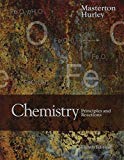
(a)
Interpretation:
The physical state (s) of water is (are) present in the flask needs to be identified.
Concept introduction:
If partial pressure of water vapor at the given temperature and volume is less than
Here, n is number of moles.
P represents pressure, V represents volume, T and R represents temperature and gas constant respectively.
Answer to Problem 77QAP
Two physical states, liquid and vapor are present in the flask.
Explanation of Solution
Given:
Volume = 10.0 L
Mass of hydrogen gas = 0.400 g
Mass of oxygen gas = 3.2 g
Reaction:
1 mole of
1 mole of
The given reaction in the question is given below:
In the above reaction,
Once
Given,
Volume ( V)
Temperature ( T)
Calculate moles ( n) of
The volume is converted from L to
The temperature is converted into Kelvin as follows:
Put all values in equation (1).
Therefore, P value is greater than
(b)
Interpretation:
The final pressure in the flask is to be determined.
Concept introduction:
Ideal
Here, n is number of moles.
P represents pressure, V represents volume, T and R represents temperature and gas constant respectively.
Answer to Problem 77QAP
Final pressure in the flask is
Explanation of Solution
Given:
Volume = 10.0 L
Mass of hydrogen gas = 0.400 g
Mass of oxygen gas = 3.2 g
Reaction:
Atomic mass of hydrogen is 1 amu and oxygen is 16 amu. Therefore, molar mass of
1 mole of
1 mole of
The given reaction in the question is given below:
In this reaction,
Once
Calculate number of moles
Given,
Volume ( V)
Temperature ( T)
Number of moles n
The volume is converted from L to
The temperature is converted into Kelvin as follows:
Since,
In previous case assuming that all water is in vapor phase. Exceed the saturation pressure some of the water will get condensed and remaining vapor will have just the pressure equal to the partial pressure, i.e.
Hence, the final pressure in the flask is
(c)
Interpretation:
The pressure in the flask is to be determined, if
Concept introduction:
Ideal gas law representation is given below.
Here, n is number of moles.
P represents pressure, V represents volume, T and R represents temperature and gas constant respectively.
Answer to Problem 77QAP
The pressure in the flask is
Explanation of Solution
Atomic mass of hydrogen is 1 amu and oxygen is 16 amu. Therefore, molar mass of
1 mole of
1 mole of
The given reaction in the question is given below:
In the above reaction,
Once
If
Given,
Volume ( V)
Temperature ( T)
Calculate number of moles ( n) of
The volume is converted from L to
The temperature is converted into Kelvin as follows:
Put all values in equation (1) to calculate partial pressure of hydrogen gas.
Converting the values of pressure from Pa to mm Hg,
If
The value of pressure is converted into atm as follows:
Therefore, pressure in the flask is
Want to see more full solutions like this?
Chapter 9 Solutions
Bundle: Chemistry: Principles and Reactions, 8th, Loose-Leaf + OWLv2, 1 term (6 months) Printed Access Card
- What is the name of the following compound? SiMe3arrow_forwardK Draw the starting structure that would lead to the major product shown under the provided conditions. Drawing 1. NaNH2 2. PhCH2Br 4 57°F Sunny Q Searcharrow_forward7 Draw the starting alkyl bromide that would produce this alkyne under these conditions. F Drawing 1. NaNH2, A 2. H3O+ £ 4 Temps to rise Tomorrow Q Search H2arrow_forward
 Chemistry: The Molecular ScienceChemistryISBN:9781285199047Author:John W. Moore, Conrad L. StanitskiPublisher:Cengage Learning
Chemistry: The Molecular ScienceChemistryISBN:9781285199047Author:John W. Moore, Conrad L. StanitskiPublisher:Cengage Learning Introductory Chemistry: A FoundationChemistryISBN:9781337399425Author:Steven S. Zumdahl, Donald J. DeCostePublisher:Cengage Learning
Introductory Chemistry: A FoundationChemistryISBN:9781337399425Author:Steven S. Zumdahl, Donald J. DeCostePublisher:Cengage Learning General Chemistry - Standalone book (MindTap Cour...ChemistryISBN:9781305580343Author:Steven D. Gammon, Ebbing, Darrell Ebbing, Steven D., Darrell; Gammon, Darrell Ebbing; Steven D. Gammon, Darrell D.; Gammon, Ebbing; Steven D. Gammon; DarrellPublisher:Cengage Learning
General Chemistry - Standalone book (MindTap Cour...ChemistryISBN:9781305580343Author:Steven D. Gammon, Ebbing, Darrell Ebbing, Steven D., Darrell; Gammon, Darrell Ebbing; Steven D. Gammon, Darrell D.; Gammon, Ebbing; Steven D. Gammon; DarrellPublisher:Cengage Learning Chemistry by OpenStax (2015-05-04)ChemistryISBN:9781938168390Author:Klaus Theopold, Richard H Langley, Paul Flowers, William R. Robinson, Mark BlaserPublisher:OpenStax
Chemistry by OpenStax (2015-05-04)ChemistryISBN:9781938168390Author:Klaus Theopold, Richard H Langley, Paul Flowers, William R. Robinson, Mark BlaserPublisher:OpenStax Chemistry: An Atoms First ApproachChemistryISBN:9781305079243Author:Steven S. Zumdahl, Susan A. ZumdahlPublisher:Cengage Learning
Chemistry: An Atoms First ApproachChemistryISBN:9781305079243Author:Steven S. Zumdahl, Susan A. ZumdahlPublisher:Cengage Learning Chemistry for Engineering StudentsChemistryISBN:9781337398909Author:Lawrence S. Brown, Tom HolmePublisher:Cengage Learning
Chemistry for Engineering StudentsChemistryISBN:9781337398909Author:Lawrence S. Brown, Tom HolmePublisher:Cengage Learning





